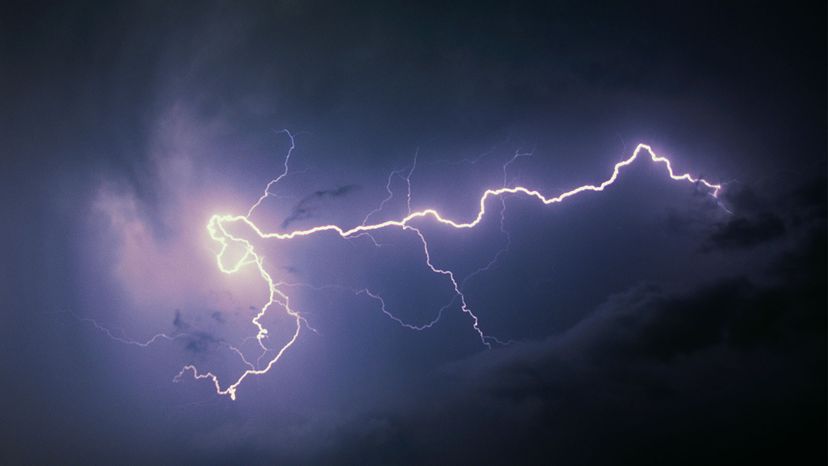Positive Streamers and Exploding Air

As the stepped leaders approach the earth, objects on the surface begin responding to the strong electric field. The objects reach out to the cloud by "growing" positive streamers. These streamers also have a purplish color and appear to be more prominent on sharp edges. The human body can and does produce these positive streamers when subjected to a strong electric field such as that of a storm cloud. In actuality, anything on the surface of Earth has the potential to send a streamer. Once produced, the streamers do not continue to grow toward the clouds; bridging the gap is the job of the stepped leaders as they travel downward.
Next to occur is the actual meeting of a stepped leader and a streamer. The streamer that the stepped leader reaches is not necessarily the closest streamer to the cloud. It's very common for lightning to strike the ground even though there is a tree or a light pole or any other tall object in the vicinity. The fact that the stepped leader does not take the path of a straight line allows for this to occur.
Advertisement
After the stepped leader and the streamer meet, the ionized air (plasma) has completed its journey to the earth, leaving a conductive path from the cloud to the ground. The resulting flash is both bright and incredibly hot.
Any time there is an electrical current, there is also heat associated with the current. Since there is an enormous amount of current in a lightning strike, there is also an enormous amount of heat that causes a brilliant white-blue flash that we see.
When a leader and a streamer meet and the current flows (the strike), the air around the strike becomes extremely hot. So hot that it actually explodes because the heat causes the air to expand so rapidly. The explosion is soon followed by what we all know as thunder.
Thunder is the shockwave radiating away from the strike path. When the air heats up, it expands rapidly, creating a compression wave that propagates through the surrounding air. This compression wave manifests itself in the form of a sound wave. That does not mean that thunder is harmless. On the contrary, if you are close enough, you can feel the shockwave as it shakes the surroundings. Keep in mind that when a nuclear explosion occurs, typically the most destruction is caused by the energy of the rapidly moving shockwave.
In fact, the shockwave that produces the thunder from a lightning strike can most certainly damage structures and people. This danger is more prominent when you are close to the strike, because the shockwave is stronger there and will dampen (decrease) with distance. Physics teaches us that sound travels much slower than light, so we see the flash before we hear the thunder. In air, sound travels roughly 1 mile (1.6 kilometers) every 4.5 seconds. Light travels at a blazing 186,000 miles (299,000 kilometers) per second.